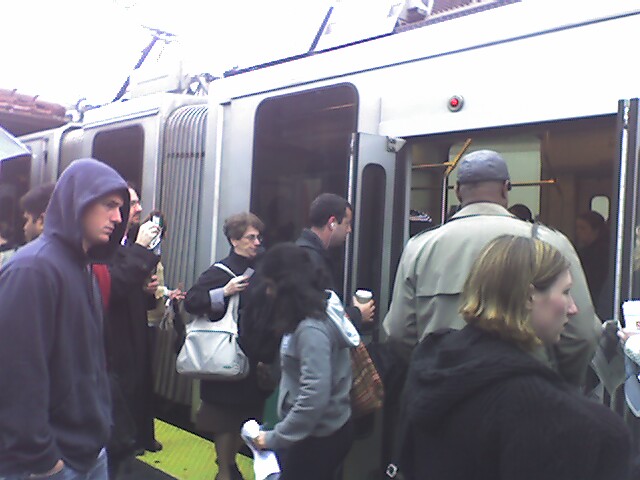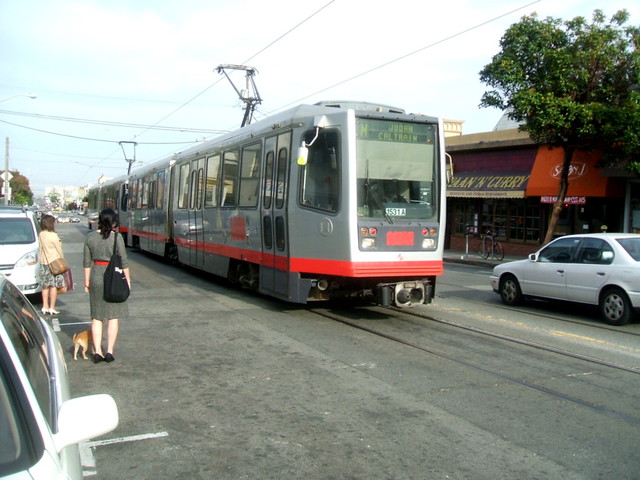 |
| Coolidge Corner on the "C" line (source) |
One of the issues that came up in the recent
MBTA public hearing was fare evasion. There's three major categories of evasion on the Boston system:
fare-gate piggy-backing (see 00:38),
rear-door boarding on the surface and
fraudulent tickets. At the hearing, one person complained of seeing 25 tourists board a trolley without paying, at the Fenway surface station. Anyone who rides the Green Line knows that this kind of thing happens all of the time. The "B" and "C" branches are especially notorious for this, due to a combination of crowded, tiny platforms and harried operators.
Many times, the trolley driver will give up on collecting fares because the demand is so enormous that it would take too long to process everyone waiting. As it is, trolleys on these branches tend to fall behind and bunch up because boarding procedures are too slow. The MBTA instituted a
Show'n'Go policy for monthly pass-holders, where they were expected to wave the pass as they boarded in the rear.
 |
| Monthly pass-holders boarding the rear doors (source) |
Naturally, this is easy to subvert, and doesn't work for CharlieCard holders anyhow. They also tried issuing handheld validators to employees posted at the busiest surface stations, allowing people to pre-pay using their CharlieCard. This is a rather expensive "solution" however. Some operators have taken up a habit of refusing to open the rear doors -- but of course this just winds up trapping the riders wishing to disembark, and slows down service even further. Nowadays, standard procedure seems to be simply to issue a call for people "to come up front and pay your fare" if they spot someone sneaking onboard.
As seen at the meeting, people tend to have strong feelings about this issue. Slogans such as "It's only fair to pay your fare" and general sentiment seems to be tilted towards a matter of justice for those who do pay. Personally, I have a cold economic view towards fare evasion. Nobody seems to really know what the true costs of fare evasion on this system are, though it is
estimated at millions. Meanwhile, there is a cost to enforcement that is also rarely considered. Constructing fare-gate restricted stations is expensive. The Green Line Extension stations will be
$13.4 million each because of this. Even if you don't have fare-gates, forcing the driver to handle fare collection also incurs costs operationally. Increased dwell times due to slow fare collection hurts headways, and ruins the supposed core product of the agency: "rapid" transit. These issues, among others, are why some people advocate for
free public transit.
The problem is that when people's emotions run high on an issue of "fairness" they neglect to consider such bloodless items as cost/benefits analysis. Seeking 100% enforcement of fares is insane and a negative value proposition in any realistic scenario. The proper way to do this is to choose fares, evasion penalties, and collection mechanisms to maximize expected value based upon practical experience, and to accept that no system is perfect. The marginal cost of a single fare evader is extremely low because the operational costs are fixed -- the trains are going to run regardless of whether that one person is riding it. If allowing the fare evader takes a car off the roads, that would be a net benefit. But almost none of this is ever considered when people get upset about fare evasion, and it turns into a political circus instead.
 |
| Waiting for the SF Muni N (Judah) in mixed-traffic (source) |
Having written all of that, I think that the pragmatic "optimal" solution is based on the idea of
Proof-of-Payment (POP). It is used successfully by
SF Muni light rail, among others. When I visited I got to observe their system up close. Muni operates light-rail vehicles which branch out into surface street-running trolleys in the outer neighborhoods, then combine into the central Market Street subway downtown. Sound familiar? While riding I noticed several things: multi-car trains have only a single operator, people can board at any door, if you pay with cash you must take a receipt with you, and transfers are free for up to 2 hours. The result was a much more smoothly operating system, despite the fact that most of the trains operate in mixed-traffic, unlike the MBTA which seems to be
deathly afraid of dealing with that.
Advantages:
- Operator is not stressed by responsibility of collecting fares.
- All doors boarding -- much faster.
- Single operator per train is a major cost saving measure.
- Transfer system is simple and easy to understand.
- Easy to tweak: if fare evasion is too high, then increase patrols and/or increase fines. If fare evasion is low, then cut back and save money.
Disadvantages:
- Might be confusing to newbies (good signs are crucial).
- Requires occasional patrolling fare enforcement officer (already exists, though).
- Penalties must be stiff, which may be politically difficult.
- Relies on expected-value to recoup costs. The probability of getting caught may be low, but the fines should be set to recover that value. However, this tends to trigger a psychological backlash in the people who do get caught (the "why me?" effect).
I think the advantages easily outweigh the disadvantages, but it is also easy to underestimate the difficulty of getting any public agency to change its ways in Massachusetts. I do foresee the possibility of increased fines in the future, which may bring about a kind of half-hearted POP system where enforcement officers target people they observe sneaking onboard, as they do today, but with more teeth than the current laughable $15 ticket.
One thing everyone agrees about: the "B" and "C" lines are too sluggish and must be improved operationally, somehow. Following the advice of "
Organization before electronics before concrete" it seems that the simplest thing to do is to open all the doors at every station stop. Whether this would result in too much fare evasion is a matter of contention that unfortunately becomes more emotional than economic. But I believe that Proof-of-Payment is a mature and reasonable fare collection strategy that has significantly lower implementation costs than fare-gates, and is easily suitable for medium-traffic transit such as the Green Line.



One way German-speaking cities keep fare evasion down is by making sure everyone has season passes. This means offering an unlimited monthly whose cost expressed in single rides is low, about as low as that of American commuter lines or not much higher. In Berlin, it's 32. The upshot is that it reduces both the incentive to cheat and the need to buy TVMs. I do not know what awareness campaigns they use, though. In some places, the fare evasion rate is under 2%. Considering that in New York they're shitting bricks over burning 15% of the revenue on fare collection, 2% is an acceptable compromise. A few cities are up to 5%, like Vancouver, which is higher but still okay. (Unfortunately, Vancouver is planning to install fare barriers on Skytrain next year.)
ReplyDeleteThe biggest way to improve run-times on the B and C lines is to drastically cut non-major stops on the Green Line and install bus stops along the routes at those cut stops in the same way that the 57 follows the B along Commonwealth Avenue to Packard's Corner. In fact, elimination of duplicated stops by the B already served by the 57 is a perfect way to increase run-times of the B out to Packard's Corner and increase throughput and overall efficient use of transit resources.
ReplyDeleteUnfortunately, with the MBTA's ongoing operating budget issues, it may not stand muster to argue the introduction of two new bus lines and the allocation of more equipment to serve those lines, especially with the average daily cost to run a single line tied to the highly volatile cost of diesel fuel.
Other simple ways to improve run-times involve relocation of stops to the 'far side' of an intersection (permitting a train to pass a green light and stop at a station, ensuring trains don't waste time at red lights) and signal preemption/priority for trains. These have been known ways to improve light rail and transit performance for decades that the MBTA, BTD, and Brookline DOT have been slow to implement, made low priority traffic improvements, or done in such a half-assed manner as to render null any improvement.
I agree that there are many ways the Green Line could be improved, although, I don't think that introducing two new redundant bus lines is the way to do it. There is plenty of opportunity for station elimination on the "B" and "C" lines already, especially the Commonwealth Avenue portion before Packard's Corner.
DeleteI've been informed that Brookline was ready, willing and able to implement signal priority on their portion of the "C" line. Last year, I got an opportunity to ask the head of Green Line operations why this had not yet been worked out, and he said that they weren't ready for it. Whatever that means.
In any case, I wanted to address these issues in the organization>electronics>concrete order and I decided that POP came first.